Abstract
An epidemiological study of porcine reproductive and respiratory syndrome (PRRS) within pig herds was conducted in 8 intensive farrow-to-finish pig farms. Persistence of PRRS virus (PRRSV) in pig herds was demonstrated by regular postmortem examination on 2 farms for a period of 2 y. Virus isolation and serum neutralization (SN) tests were performed on the sera collected from 9 groups of pigs (10 pigs/group) of various ages on 8 pig farms. Except for 1 farm, isolation rates of PRRSV reached the highest level of 70 to 100% of pigs 6 to 8 wk of age, which coincided with the lowest levels of maternal immunity. In 1 pig herd, sows (39 in total) with SN titers of < or = 1:2, 1:4-1:8, and > or = 1:16 were designated as groups 1, 2, and 3, respectively. Sera were obtained from their progeny (3 pigs randomly selected from each litter) at various ages from 0 to 22 weeks. A positive correlation (r = 0.377, P < 0.001) between the SN titers of sows and those of their progeny (1-week-old piglets) was observed. Pigs at the age of 6 wk, only 7.9% of group 1 pigs compared to 72.4% of group 3 pigs were seropositive. A significant difference (P < 0.01) in the percentage of pigs with PRRSV viremia among the 3 groups was observed, with the lowest level found in group 3 pigs. The isolation rates of PRRSV from serum reached the maximum at the age of 9 wk for all 3 groups. The results indicated that passively acquired serum antibodies conferred a protective effect for piglets; however, loss of passive immunity at various ages of pigs produced susceptible pigs that resulted in PRRSV persistence in the pig herds. Pigs 6 to 9 weeks old were the major reservoir for PRRSV in farrow-to-finish pig herds.
Full text
PDF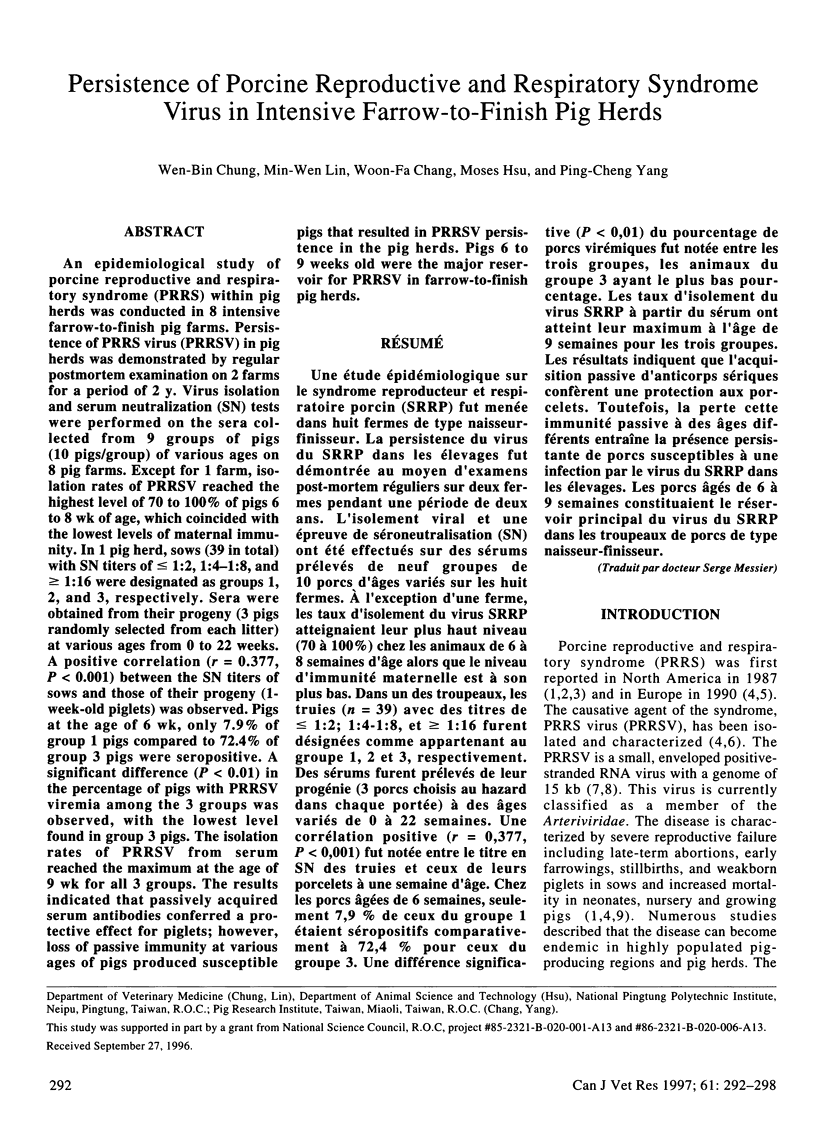
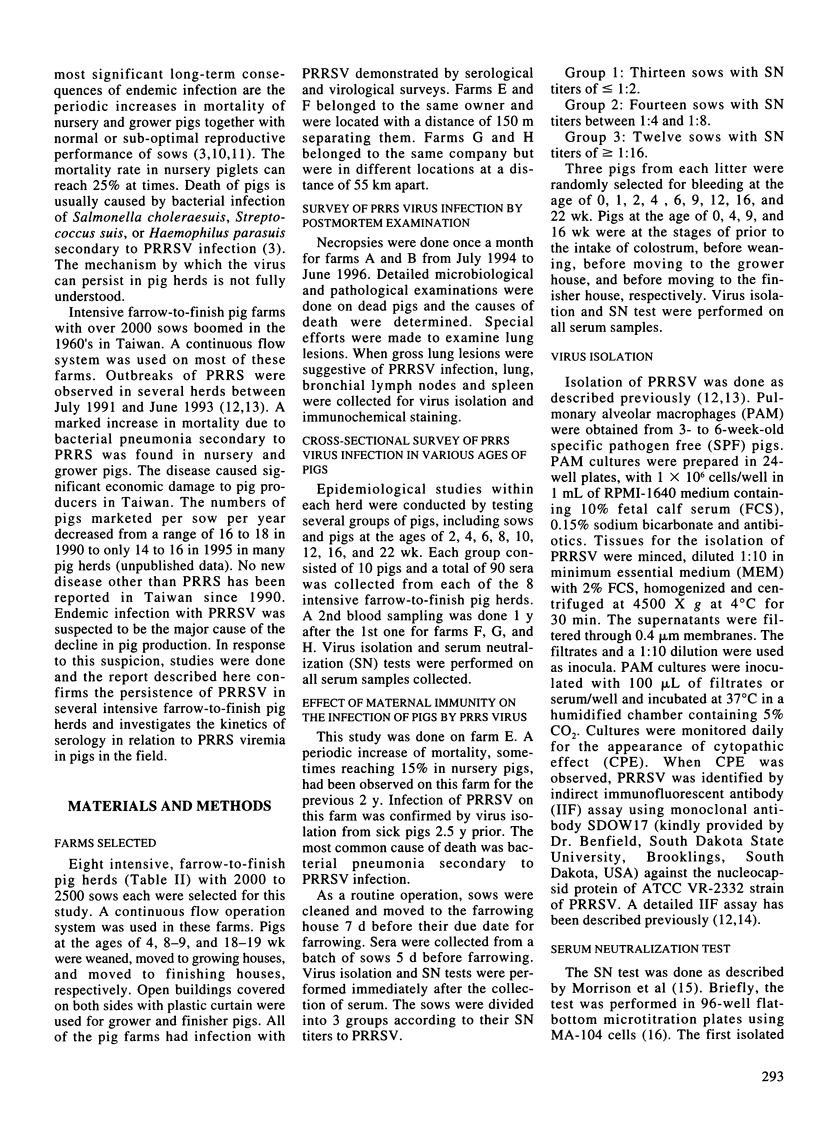

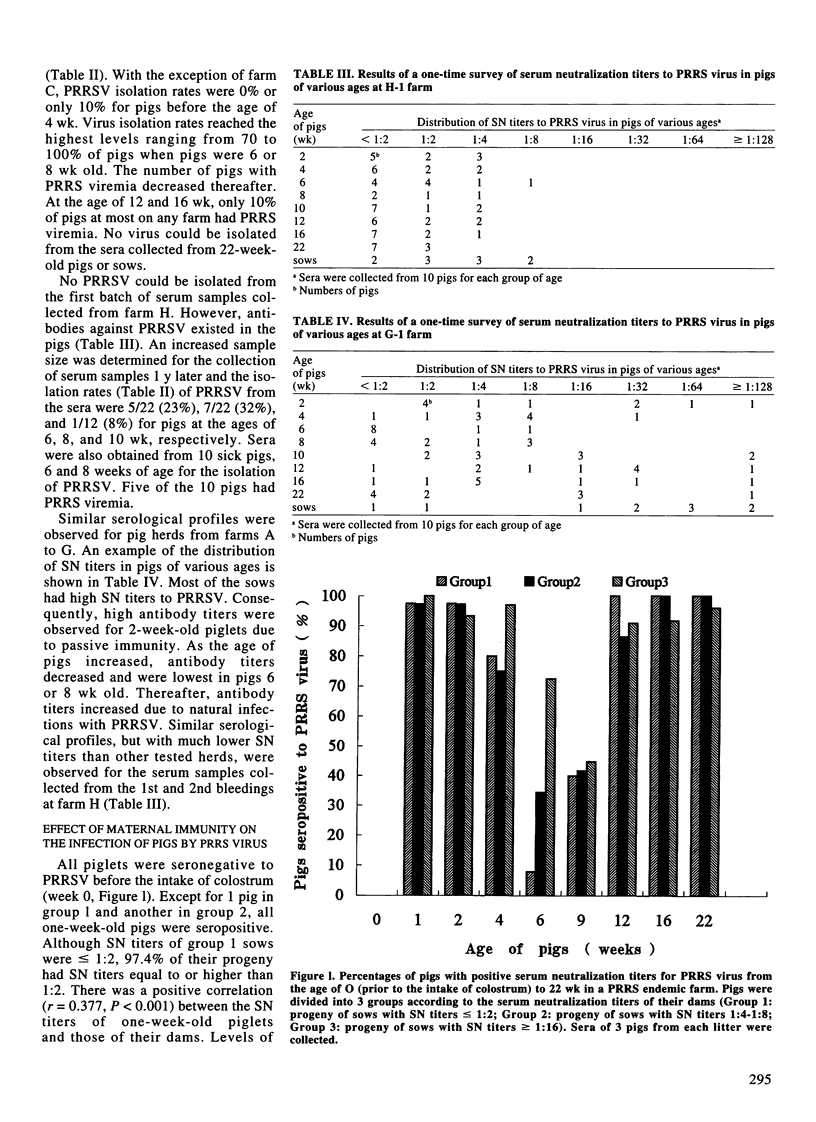
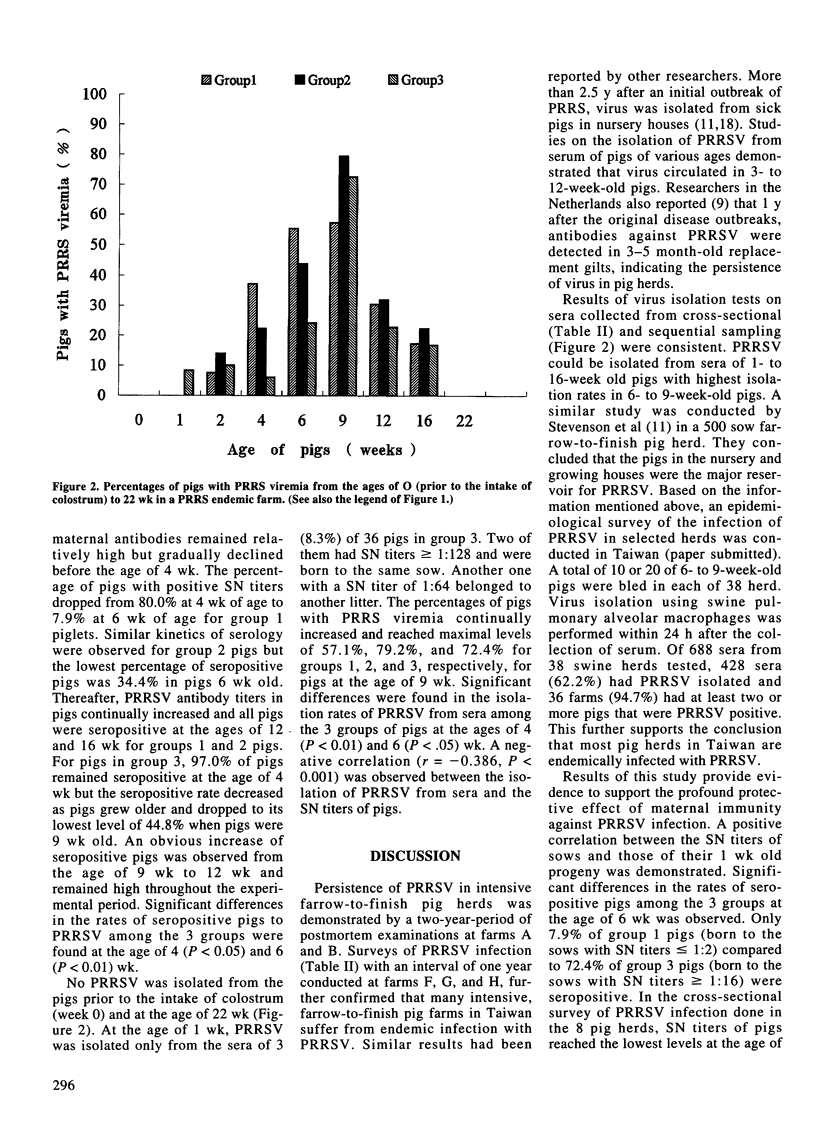

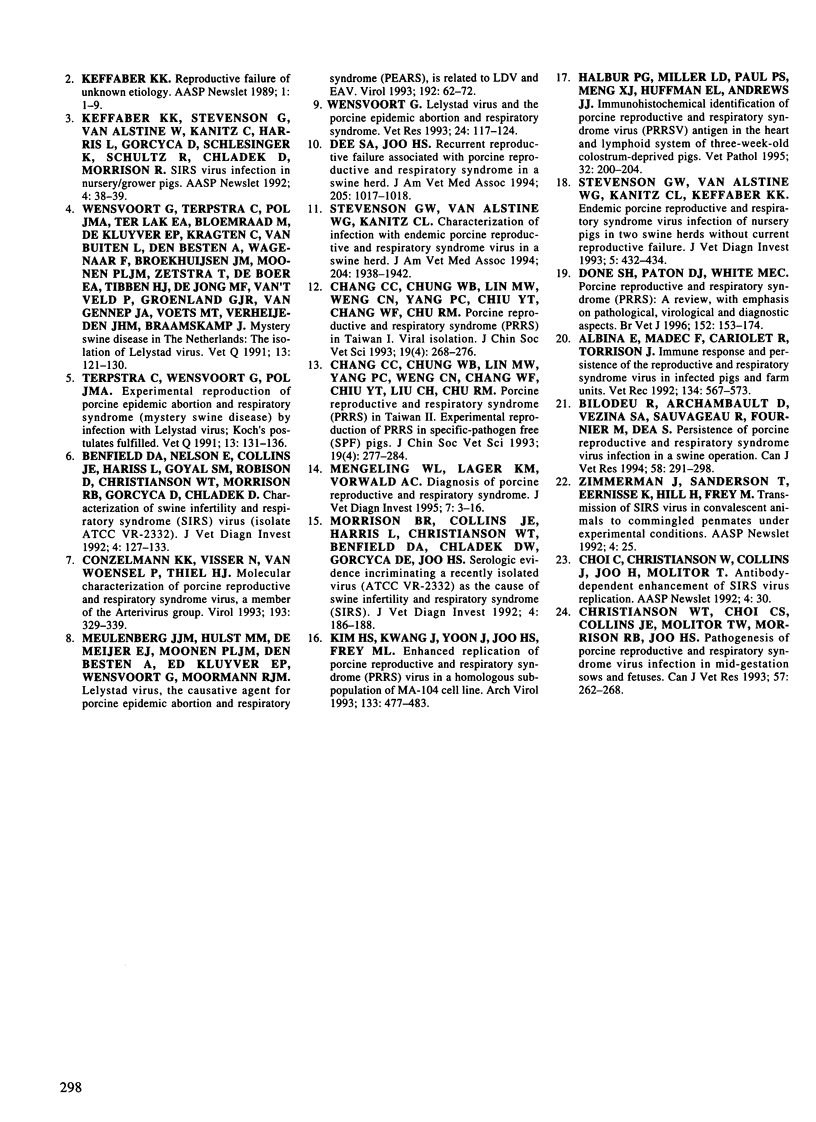
Selected References
These references are in PubMed. This may not be the complete list of references from this article.
- Albina E., Madec F., Cariolet R., Torrison J. Immune response and persistence of the porcine reproductive and respiratory syndrome virus in infected pigs and farm units. Vet Rec. 1994 May 28;134(22):567–573. doi: 10.1136/vr.134.22.567. [DOI] [PubMed] [Google Scholar]
- Benfield D. A., Nelson E., Collins J. E., Harris L., Goyal S. M., Robison D., Christianson W. T., Morrison R. B., Gorcyca D., Chladek D. Characterization of swine infertility and respiratory syndrome (SIRS) virus (isolate ATCC VR-2332). J Vet Diagn Invest. 1992 Apr;4(2):127–133. doi: 10.1177/104063879200400202. [DOI] [PubMed] [Google Scholar]
- Bilodeau R., Archambault D., Vézina S. A., Sauvageau R., Fournier M., Dea S. Persistence of porcine reproductive and respiratory syndrome virus infection in a swine operation. Can J Vet Res. 1994 Oct;58(4):291–298. [PMC free article] [PubMed] [Google Scholar]
- Christianson W. T., Choi C. S., Collins J. E., Molitor T. W., Morrison R. B., Joo H. S. Pathogenesis of porcine reproductive and respiratory syndrome virus infection in mid-gestation sows and fetuses. Can J Vet Res. 1993 Oct;57(4):262–268. [PMC free article] [PubMed] [Google Scholar]
- Collins J. E., Benfield D. A., Christianson W. T., Harris L., Hennings J. C., Shaw D. P., Goyal S. M., McCullough S., Morrison R. B., Joo H. S. Isolation of swine infertility and respiratory syndrome virus (isolate ATCC VR-2332) in North America and experimental reproduction of the disease in gnotobiotic pigs. J Vet Diagn Invest. 1992 Apr;4(2):117–126. doi: 10.1177/104063879200400201. [DOI] [PubMed] [Google Scholar]
- Conzelmann K. K., Visser N., Van Woensel P., Thiel H. J. Molecular characterization of porcine reproductive and respiratory syndrome virus, a member of the arterivirus group. Virology. 1993 Mar;193(1):329–339. doi: 10.1006/viro.1993.1129. [DOI] [PMC free article] [PubMed] [Google Scholar]
- Dee S. A., Joo H. S. Recurrent reproductive failure associated with porcine reproductive and respiratory syndrome in a swine herd. J Am Vet Med Assoc. 1994 Oct 1;205(7):1017–1018. [PubMed] [Google Scholar]
- Done S. H., Paton D. J., White M. E. Porcine reproductive and respiratory syndrome (PRRS): a review, with emphasis on pathological, virological and diagnostic aspects. Br Vet J. 1996 Mar;152(2):153–174. doi: 10.1016/S0007-1935(96)80071-6. [DOI] [PMC free article] [PubMed] [Google Scholar]
- Halbur P. G., Miller L. D., Paul P. S., Meng X. J., Huffman E. L., Andrews J. J. Immunohistochemical identification of porcine reproductive and respiratory syndrome virus (PRRSV) antigen in the heart and lymphoid system of three-week-old colostrum-deprived pigs. Vet Pathol. 1995 Mar;32(2):200–204. doi: 10.1177/030098589503200218. [DOI] [PubMed] [Google Scholar]
- Kim H. S., Kwang J., Yoon I. J., Joo H. S., Frey M. L. Enhanced replication of porcine reproductive and respiratory syndrome (PRRS) virus in a homogeneous subpopulation of MA-104 cell line. Arch Virol. 1993;133(3-4):477–483. doi: 10.1007/BF01313785. [DOI] [PubMed] [Google Scholar]
- Mengeling W. L., Lager K. M., Vorwald A. C. Diagnosis of porcine reproductive and respiratory syndrome. J Vet Diagn Invest. 1995 Jan;7(1):3–16. doi: 10.1177/104063879500700102. [DOI] [PubMed] [Google Scholar]
- Meulenberg J. J., Hulst M. M., de Meijer E. J., Moonen P. L., den Besten A., de Kluyver E. P., Wensvoort G., Moormann R. J. Lelystad virus, the causative agent of porcine epidemic abortion and respiratory syndrome (PEARS), is related to LDV and EAV. Virology. 1993 Jan;192(1):62–72. doi: 10.1006/viro.1993.1008. [DOI] [PMC free article] [PubMed] [Google Scholar]
- Morrison R. B., Collins J. E., Harris L., Christianson W. T., Benfield D. A., Chladek D. W., Gorcyca D. E., Joo H. S. Serologic evidence incriminating a recently isolated virus (ATCC VR-2332) as the cause of swine infertility and respiratory syndrome (SIRS). J Vet Diagn Invest. 1992 Apr;4(2):186–188. doi: 10.1177/104063879200400212. [DOI] [PubMed] [Google Scholar]
- Stevenson G. W., Van Alstine W. G., Kanitz C. L. Characterization of infection with endemic porcine reproductive and respiratory syndrome virus in a swine herd. J Am Vet Med Assoc. 1994 Jun 15;204(12):1938–1942. [PubMed] [Google Scholar]
- Stevenson G. W., Van Alstine W. G., Kanitz C. L., Keffaber K. K. Endemic porcine reproductive and respiratory syndrome virus infection of nursery pigs in two swine herds without current reproductive failure. J Vet Diagn Invest. 1993 Jul;5(3):432–434. doi: 10.1177/104063879300500322. [DOI] [PubMed] [Google Scholar]
- Terpstra C., Wensvoort G., Pol J. M. Experimental reproduction of porcine epidemic abortion and respiratory syndrome (mystery swine disease) by infection with Lelystad virus: Koch's postulates fulfilled. Vet Q. 1991 Jul;13(3):131–136. doi: 10.1080/01652176.1991.9694297. [DOI] [PubMed] [Google Scholar]
- Wensvoort G. Lelystad virus and the porcine epidemic abortion and respiratory syndrome. Vet Res. 1993;24(2):117–124. [PubMed] [Google Scholar]
- Wensvoort G., Terpstra C., Pol J. M., ter Laak E. A., Bloemraad M., de Kluyver E. P., Kragten C., van Buiten L., den Besten A., Wagenaar F. Mystery swine disease in The Netherlands: the isolation of Lelystad virus. Vet Q. 1991 Jul;13(3):121–130. doi: 10.1080/01652176.1991.9694296. [DOI] [PubMed] [Google Scholar]


